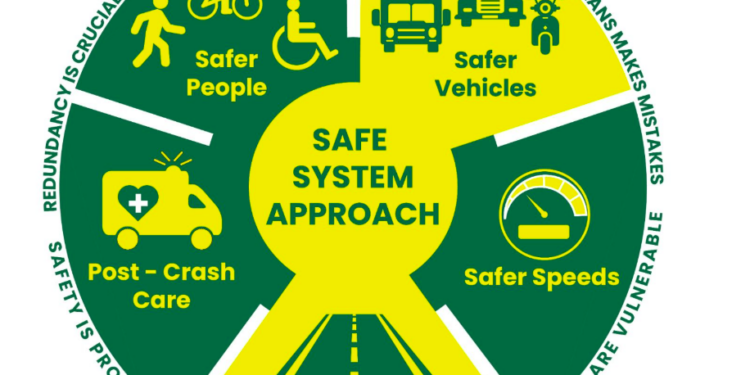In a bold move to address the persistent crisis of road accidents, Kenya is eyeing a transformative strategy known as the Safe System approach—a globally recognised framework that could mark a new era in traffic safety management across the country.
A New Direction in Road Safety Policy
As road traffic deaths continue to claim thousands of lives annually in Kenya, stakeholders across the public and private sectors are seeking smarter, more human-centered strategies. One of the most promising? The Safe System approach—a safety philosophy pioneered in Sweden and the Netherlands during the 1990s, now adopted by countries like Australia, India, and Canada.
At its core, this system recognises a key truth: human error is inevitable, but death and serious injury on roads are not.
Instead of placing the entire burden of safety on drivers, this approach advocates for safer road design, smarter vehicle technologies, enforced speed management, and strong post-crash response systems. It’s a shared responsibility—between road users, engineers, regulators, and vehicle manufacturers.
🚗 **Read more about Kenya’s latest road safety strategies on **Automag Kenya – your source for car reviews, driving tips, and traffic safety updates.
How the Safe System Works: Core Principles
Unlike traditional traffic management strategies that often blame individuals, the Safe System model spreads accountability and proactively prevents harm. The philosophy is built on several key principles:
- Mistakes will happen—but the consequences shouldn’t be fatal.
- Humans are vulnerable—roads must be designed with human limits in mind.
- Responsibility is shared—governments, transport planners, drivers, and law enforcers must work together.
- Safety measures must be proactive, not reactive.
- System design must be layered and redundant—so that if one safety feature fails, others compensate.
These principles are implemented through five core pillars: safe road users, safe vehicles, safe roads, safe speeds, and effective post-crash care.
🛣️ Want to explore vehicle safety features in detail? Check out this guide on safe vehicles in Kenya.
Lessons for Kenya: What Needs to Change?
Experts in Kenya believe this approach can be a game-changer—but only if applied holistically.
1. Safer Roads for All
In many parts of Kenya, especially in growing cities like Nairobi, poor road planning and limited pedestrian infrastructure contribute to accidents. The Safe System calls for features like dedicated bike lanes, pedestrian islands, and barrier-separated lanes for different traffic speeds.
Already, countries like the Netherlands have achieved dramatic safety improvements using these designs. Kenya can start with urban centres and gradually expand to high-risk rural corridors.
2. Speed Management
Speed is a major factor in the severity of crashes. Enforcing appropriate speed limits, especially near schools, markets, and residential areas, is critical. The introduction of digital speed enforcement, more speed bumps, and intelligent signage could save hundreds of lives annually.
🚦 For tips on defensive driving and obeying traffic laws, read this essential guide for Kenyan drivers.
3. Modern Vehicle Standards
Vehicles in Kenya—particularly second-hand imports—often lack the latest safety features. While cost is a concern, ensuring minimum safety standards such as airbags, anti-lock brakes, and electronic stability control (ESC) must be prioritised.
For those in the market for safe, affordable vehicles, platforms like ht/auto24.co.ke/ offer a variety of reliable used cars that meet safety criteria. Popular options include the Toyota Axio, Mazda Demio, and Nissan Note, which balance affordability with performance.
4. Post-Crash Emergency Response
Improving how quickly and effectively emergency services respond to road crashes is crucial. Well-trained medics, equipped ambulances, and real-time crash detection systems can reduce fatalities from survivable injuries.
The government’s recent investment in the Kenya Transport Accident Investigation Bureau (KTAIB) is a step in the right direction.
Rural Roads Need Tailored Solutions
While Nairobi often grabs the headlines, some of the deadliest roads are found in rural areas. Inadequate signage, poor lighting, and long emergency response times contribute to the problem. The government must invest in rural road upgrades, focusing on safety for pedestrians, boda boda riders, and school children who use the roads daily.
To find second-hand vehicles suitable for tough rural terrains, explore auto24.co.ke for options like the Toyota Hilux, Isuzu D-Max, and Suzuki Jimny—vehicles known for their rugged performance and durability.
🚙 Looking to buy a used SUV or pickup for off-road conditions? Browse listings on AUTO24 Kenya for deals on cars that meet rural mobility needs.
A Shared Future: Everyone Has a Role
The Safe System approach encourages all stakeholders to play an active role in road safety—from drivers and cyclists to city planners and national regulators. As Kenya implements its National Road Safety Action Plan (2024–2028), integrating Safe System principles could be the key to reversing the trend of rising traffic deaths.
For ongoing updates and expert insights on automotive policy, safety tips, and reviews tailored to Kenyan drivers, visit automag.co.ke.
Final Thoughts
Transforming road safety in Kenya won’t happen overnight. But with political will, community education, smarter infrastructure, and policy innovation inspired by global best practices, the country can pave the way for a safer, more inclusive future on its roads.




